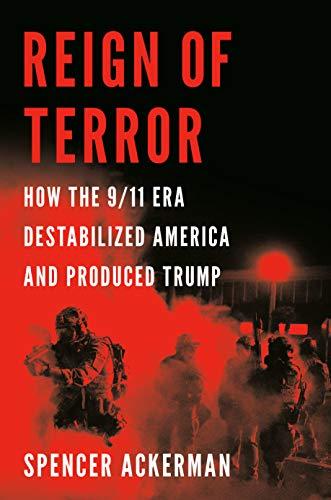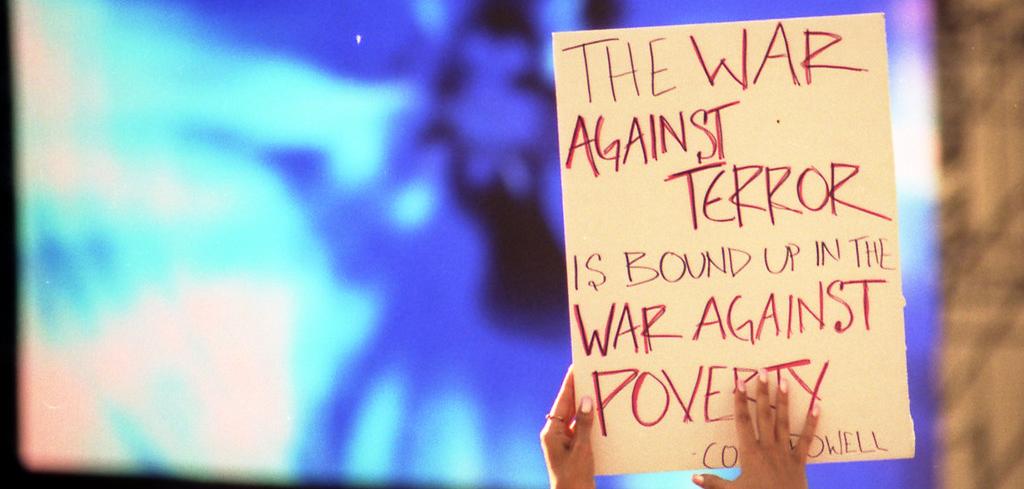Reading Spencer Ackerman’s new book Reign of Terror: How the 9/11 Era Destabilized America and Produced Trump (Penguin Random House, 2021) is a horrifying experience. Ackerman—a Pulitzer Prize-winning journalist who has written for The Guardian, WIRED, and The Daily Beast—immerses the reader in the minutia of the War on Terror and its consequences. I won’t mince words; even for someone who closely followed the brain-numbing, soul-jarring developments in U.S. wars at home and abroad, this recounting of the torture, bombing, and morally bankrupt violence and mendacity of the last two decades is a difficult read. Difficult not because it is a theoretically dense account—it isn’t—but because the raw suffering of so many victims, and the callousness and viciousness of so many fellow citizens, is front and center.
With a perhaps inevitable reference to Trump, the book’s title is not so much inaccurate as drastically incomplete. Ackerman’s account takes us on a tour of three administrations, Republican and Democratic, and into the belly of the security state beast. The cumulative effect is a picture of the business-as-usual uses of surveillance, repression, and violence against Arab and Muslim Americans day after day and year after year, regardless of who sits in the White House. This, he notes, is in stark contrast with the ways in which White nationalist violence, consistently the most deadly, has been neglected or ignored by federal law enforcement.

The two lanes where Reign of Terror makes important analytical contributions are first in recognizing the multi-sided politics of the continuity between the Bush, Obama, and Trump administrations; and second in noting how our brutalizing and racist foreign policy has had implications for our brutalizing, racist domestic policy. Regarding the first, Ackerman points out that for both neoconservatives (epitomized by Vice President Cheney) and ethnonationalists (such as Trump aide Stephen Miller, although Ackerman uses the unfortunate term “nativists” to describe figures like him), the “War on Terror” was conceived of as a clash between civilizations. The ultimate enemy for both crowds, but particularly the nationalists, was Islam itself, and both camps demanded the proximate enemy be called “radical Islamic terrorism.” For the foreign policy realists in the security state, the task was to maintain the paramount position of the U.S. on the world stage. From their point of view, a military response to 9/11 was important to signal American resolve, but over-committing to expensive wars in geopolitical backwaters (Afghanistan) or regional tinderboxes (Iraq) was counterproductive. While ultimately aligned with the realists, the Obama administration enraged the ethnonationalists and annoyed the neocons by rejecting the war-of-civilizations model—signaling that the designated enemy was “violent extremists” of whatever flavor, with al-Qa’ida and Osama bin Laden topping the list. The federal Countering Violent Extremism program Obama launched to address them could in theory target any kind of political violence, but, Ackerman writes, “its overwhelming focus was on U.S. Muslim communities.” Moreover, it was vague enough that Trump-era officials could use it to describe racial justice protestors.
As Ackerman points out, all these factions are invested in American exceptionalism—an idea Ackerman describes tellingly, if somewhat telegraphically, as “nothing more than white innocence applied globally.” In the author’s terms, exceptionalism is a kind of “civic religion” as old as the republic—a mostly unquestioned assumption that the United States has the right to “set terms for the world that it was not itself bound by, a global policeman’s doctrine of qualified immunity.” Shaped by this corrosive doctrine, not only the Right but the Center and Center-Left, indeed the security state itself, were ill-equipped to understand that U.S. wars and interventions abroad would produce not only resentment but retaliatory violence.
Ackerman argues, correctly I think, that the split within the U.S. Right, between the neoconservatives and the ethnonationalists, was a divide between two versions of American exceptionalism. Both leaned into explanations for 9/11 that featured a primordial war of civilizations, the more-or-less inevitable consequence of clashing ideologies. For the neocons, at issue was a pathological characterization of Arab and Muslim-majority societies. In their view, any talk of the history of Western imperialism and exploitation was a cowardly refusal to see the real problem: “Islam’s failure to be civilized.” The only failure they were willing to recognize was a failure of the will to engage in a war of permanent subjugation. The “nativists,” by contrast, viewed the conflict between “Islam” and the “West” primarily in defensive and conspiracist terms. Ackerman quotes ethnonationalist writer Roger McGrath to make the point: “While America ‘send[s] our boys overseas to fight and die, ostensibly to protect the United States,’ its elites flooded America with foreigners.”[1]
The neoconservative/ethnonationalist discord is a useful lens for understanding tensions within the U.S. Right, but Ackerman’s account doesn’t really identify the extent to which the ethnonationalists triumphed with the election of Donald Trump. He notes the merger of immigration policy and security, but does not identify the extent to which the anti-immigrant movement supplied both the personnel and the policies that drove this process.[2] Nor does he identify the reach of the MAGA movement and its chokehold on the Republican Party. For example, the vast machinery of the Christian Right was a key component of the Trump base and has long seen Islam as not only a subversive force, but a demonic one.[3] Ackerman does good work, however, in exploring the devastating consequences of the War on Terror at home, dispelling the tendency to over-focus responsibility on the Bush Administration and the neocons. And in chapters 3 (“Liberal Complicity in the War on Terror”) and 4 (“Obama and the ‘Sustainable’ War on Terror”), he does great work, dispelling the obfuscation that tends to hide the extent to which the War on Terror was enthusiastically supported by Democratic politicians. He points out how Obama’s pivot from talking about “radical Islam” to “violent extremists” was a double-edged razor. On the one hand, Obama rejected the clash-of-civilizations framework that identified Islam and Muslims as enemies. On the other, the “extremism” language was little more than a fig leaf for intensified surveillance and barely coded suspicion directed against Muslim-Americans. Under the auspices of Obama’s Countering Violent Extremism (CVE) Task Force, far-right and White nationalist threats were mostly ignored.
The largest problems with the CVE model and its most recent spin-off, “Domestic Violent Extremism,” are not just that these programs failed to recognize right-wing threats, but that they view these threats—which are at base cultural and political—almost exclusively through the lens of law enforcement. They justify mass surveillance, pre-emptive violence, and stigmatization of entire communities, and receive massive funding to do so. In other words—and it is disappointing that the author does not do more to tease this out—the post-9/11 treatment of an entire community as suspect by the security state and the devolution of surveillance and militarization of enforcement to local policing are not new. Surely the callousness with which the War on Terror has been pursued has impacted the militarization of policing and the border, but these trends go back to the War on Crime, the War on Drugs, and even the War on Poverty. (See Elizabeth Hinton’s excellent 2017 book From the War on Poverty to the War on Crime: The Making of Mass Incarceration.) Ackerman does point out the ways in which torture of Black “suspects” has been a feature of U.S. policing, noting that Richard Zuley, one of the Chicago cops at the center of the decades-long Chicago PD racist torture scandal, was sent to Guantanamo to be an interrogator in 2002. But there’s much more to the story of how anti-Blackness and anti-Indigenous brutality have been in constant dialogue with U.S. military adventurism and brutalizing foreign policy, with influences running in both directions.
Endnotes
- Roger D. McGrath, “The Great Somali Welfare Hunt,” The American Conservative, November 18, 2002, quoted in Ackerman p. 57.
- Ethan Fauré, “Where the White House Gets its Racist Immigration Policies,” Political Research Associates, March 1, 2018, https://politicalresearch.org/2018/03/01/where-the-white-house-gets-its-racist-immigration-policies.
- Eric Gormly, “Peering Beneath the Veil: An Ethnographic Content Analysis of Islam as Portrayed on The 700 Club Following the September 11th Attacks,” Journal of Media and Religion 3(4), 219-238, at 235.

